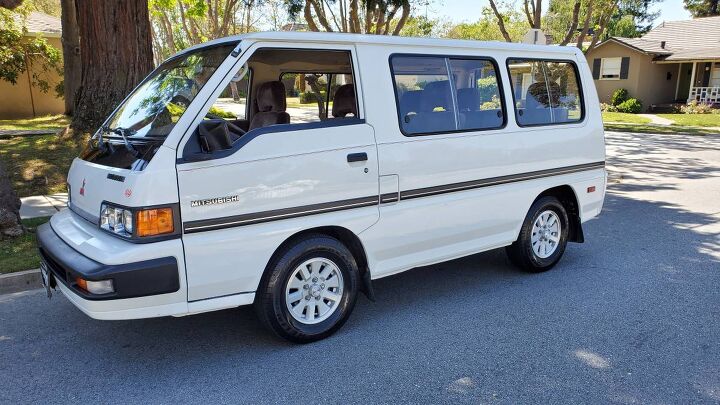Rare Rides: The 1988 Mitsubishi Wagon, Forgotten Long Ago

Rare Rides has featured a couple of JDM import vans previously, namely the Mazda Bongo and Toyota Town Ace. Today’s van is of similar JDM fashion, except this Mitsubishi is one of the few examples actually sold in North America during the model’s very short domestic run.
Let’s learn a bit more about the only large van Mitsubishi ever sold in America. Once again, it’s Van Time.
Known by various names all over the world, Mitsubishi’s van offering was always called Delica at home. It entered production late in 1968 for the ’69 model year, and consisted of a cargo van body applied to a tiny cab-over pickup. Simple as it was, the Delica established itself as an almost immediate market success around the world. Especially successful in Indonesia, the tiny van was marketed as the Colt. Colt branding was so powerful the word was adopted into local lexicon to mean small van.
1979 brought with it a second-generation Delica that was much larger, carrying an appearance more consistent with a modern cab-over Japanese van. Another long-lived generation, the second Delica was in production for most markets through 1986. It lived through 2018 in Indonesia, and its Seventies design continues production in the Philippines today.
In 1986, the third-generation Delica expanded the lineup with regard to branding, engine, and transmission offerings. Wearing 13 different badges depending on market, the Delica was initially produced in five different countries. It was popular enough that Mitsubishi extended its run through 2013, and the van is still made in Taiwan today. Available engines included various inline-fours burning gasoline and diesel, and ranging in displacement from 1.4 liters to 2.6 liters. Transmissions were of four, five, or six speeds, and included manual and automatic varieties. Four-wheel drive was available in some configurations.
Japanese manufacturers were caught by surprise with the instant success of the Chrysler minivan in the mid-Eighties. Prior to 1987, Mitsubishi offered no van in the North American market; the closest product was the Expo MPV. Hopeful they could shift an all-new product in America, Mitsubishi brought over their Van and Wagon for the 1987 model year. Van was chosen as the label for cargo carrying Mitsubishis with no side windows, while Wagon was used for passenger version. The only available engine for North American market vans was the largest 2.4-liter gasoline unit (which would later power the Eclipse).
However, North Americans never warmed too well to cab-over vans, no matter who tried to shift them. The poor crash protection, awkward entry and exit, and less-than-ideal handling put customers straight into domestic showrooms (and forced creation of product like the Honda Odyssey and Toyota Sienna). Available only until 1990, the Mitsubishi Van and Wagon were quickly forgotten. Enthusiast interest continues for the international four-wheel-drive Delica models, which are regularly imported to the US by an enterprising specialist dealer.
Today’s Rare Ride was for sale in San Francisco, with a pristine brown velour interior. With its rarity and superb condition, it lasted online just two days before being sold. The ask was $3,400.
[Images: seller]

Interested in lots of cars and their various historical contexts. Started writing articles for TTAC in late 2016, when my first posts were QOTDs. From there I started a few new series like Rare Rides, Buy/Drive/Burn, Abandoned History, and most recently Rare Rides Icons. Operating from a home base in Cincinnati, Ohio, a relative auto journalist dead zone. Many of my articles are prompted by something I'll see on social media that sparks my interest and causes me to research. Finding articles and information from the early days of the internet and beyond that covers the little details lost to time: trim packages, color and wheel choices, interior fabrics. Beyond those, I'm fascinated by automotive industry experiments, both failures and successes. Lately I've taken an interest in AI, and generating "what if" type images for car models long dead. Reincarnating a modern Toyota Paseo, Lincoln Mark IX, or Isuzu Trooper through a text prompt is fun. Fun to post them on Twitter too, and watch people overreact. To that end, the social media I use most is Twitter, @CoreyLewis86. I also contribute pieces for Forbes Wheels and Forbes Home.
More by Corey Lewis
Latest Car Reviews
Read moreLatest Product Reviews
Read moreRecent Comments
- Theflyersfan OK, I'm going to stretch the words "positive change" to the breaking point here, but there might be some positive change going on with the beaver grille here. This picture was at Car and Driver. You'll notice that the grille now dives into a larger lower air intake instead of really standing out in a sea of plastic. In darker colors like this blue, it somewhat conceals the absolute obscene amount of real estate this unneeded monstrosity of a failed styling attempt takes up. The Euro front plate might be hiding some sins as well. You be the judge.
- Theflyersfan I know given the body style they'll sell dozens, but for those of us who grew up wanting a nice Prelude Si with 4WS but our student budgets said no way, it'd be interesting to see if Honda can persuade GenX-ers to open their wallets for one. Civic Type-R powertrain in a coupe body style? Mild hybrid if they have to? The holy grail will still be if Honda gives the ultimate middle finger towards all things EV and hybrid, hides a few engineers in the basement away from spy cameras and leaks, comes up with a limited run of 9,000 rpm engines and gives us the last gasp of the S2000 once again. A send off to remind us of when once they screamed before everything sounds like a whirring appliance.
- Jeff Nice concept car. One can only dream.
- Funky D The problem is not exclusively the cost of the vehicle. The problem is that there are too few use cases for BEVs that couldn't be done by a plug-in hybrid, with the latter having the ability to do long-range trips without requiring lengthy recharging and being better able to function in really cold climates.In our particular case, a plug-in hybrid would run in all electric mode for the vast majority of the miles we would drive on a regular basis. It would also charge faster and the battery replacement should be less expensive than its BEV counterpart.So the answer for me is a polite, but firm NO.
- 3SpeedAutomatic 2012 Ford Escape V6 FWD at 147k miles:Just went thru a heavy maintenance cycle: full brake job with rotors and drums, replace top & bottom radiator hoses, radiator flush, transmission flush, replace valve cover gaskets (still leaks oil, but not as bad as before), & fan belt. Also, #4 fuel injector locked up. About $4.5k spread over 19 months. Sole means of transportation, so don't mind spending the money for reliability. Was going to replace prior to the above maintenance cycle, but COVID screwed up the market ( $4k markup over sticker including $400 for nitrogen in the tires), so bit the bullet. Now serious about replacing, but waiting for used and/or new car prices to fall a bit more. Have my eye on a particular SUV. Last I checked, had a $2.5k discount with great interest rate (better than my CU) for financing. Will keep on driving Escape as long as A/C works. 🚗🚗🚗







































Comments
Join the conversation
I didn't know they imported a standard transmission into the US. I'll check my service manual and see if it makes reference to it.
I had one and loved it . Seated 7 people . Easy to park , great van